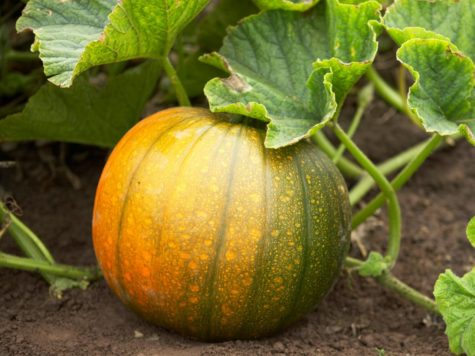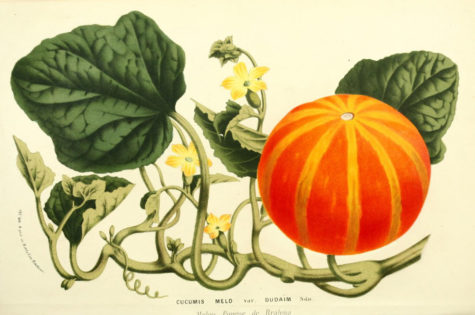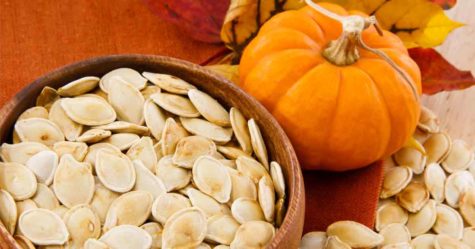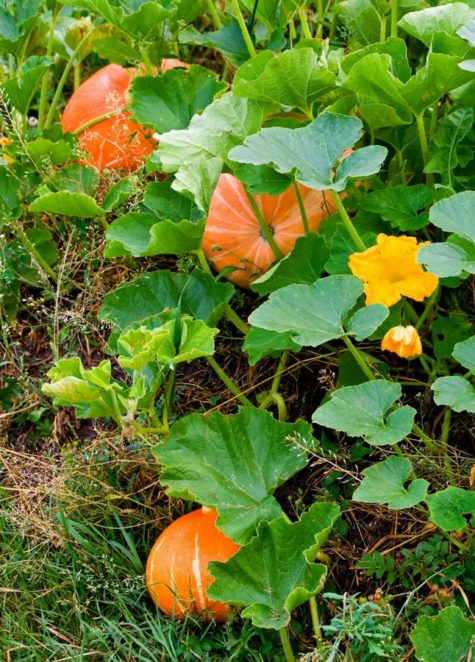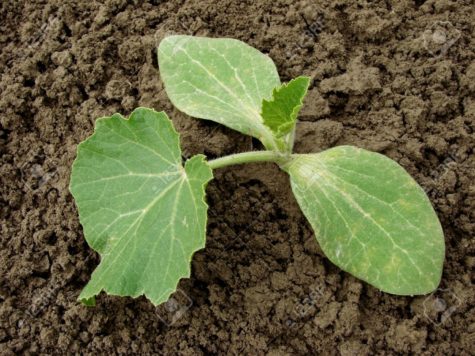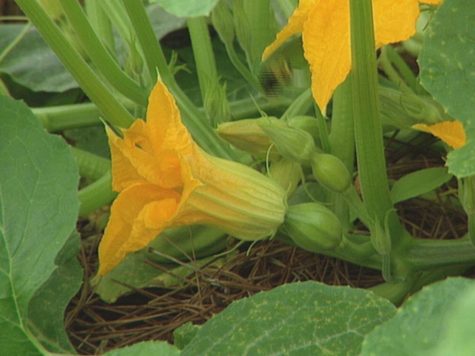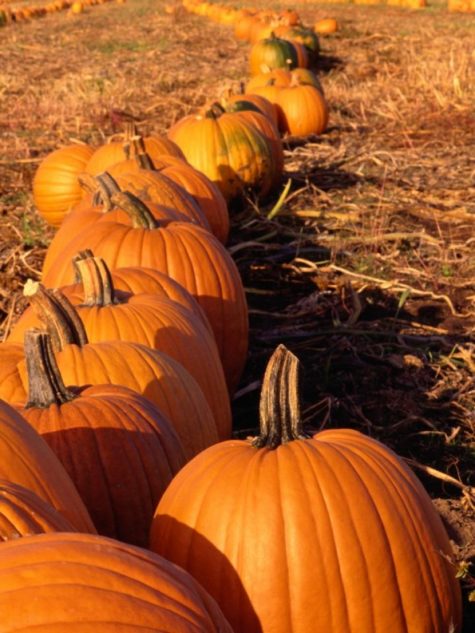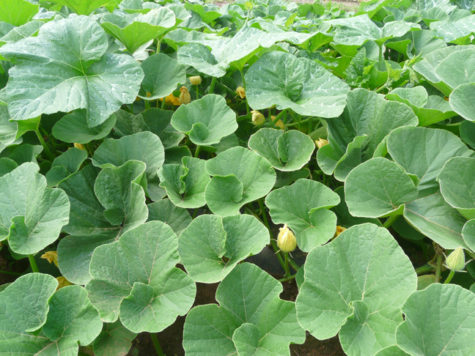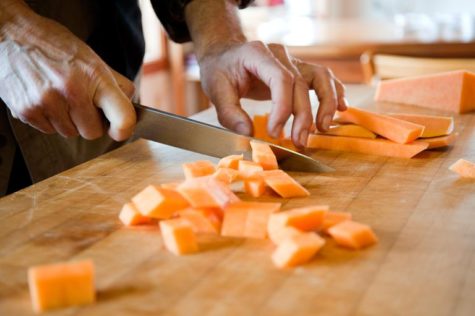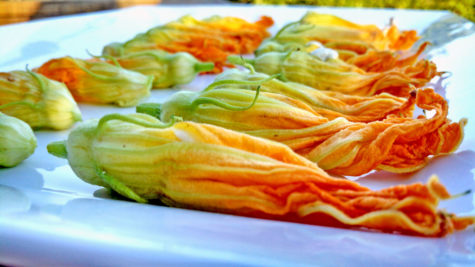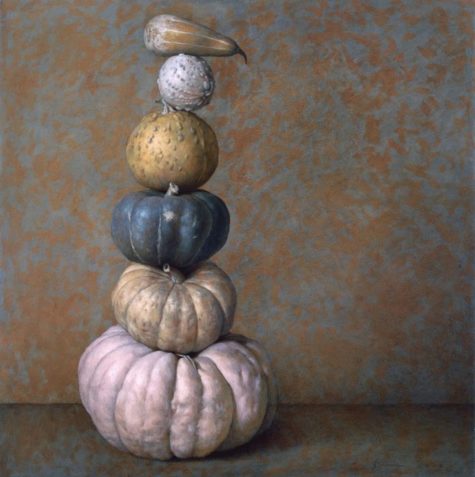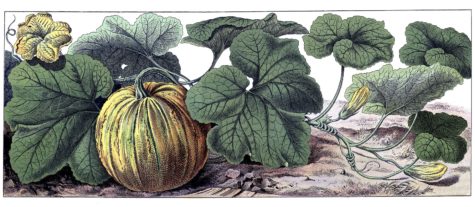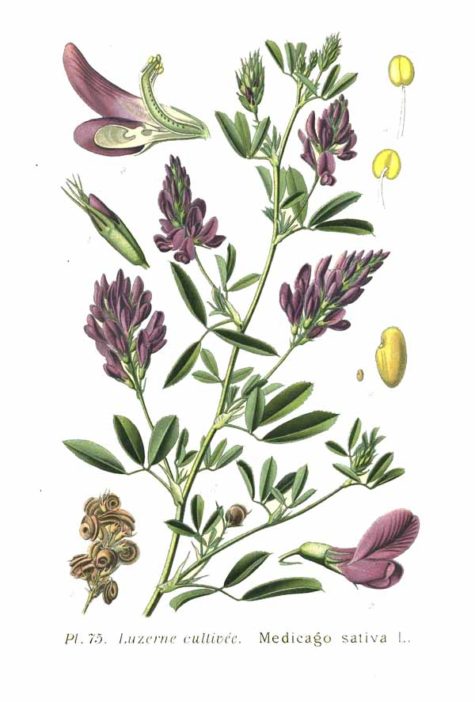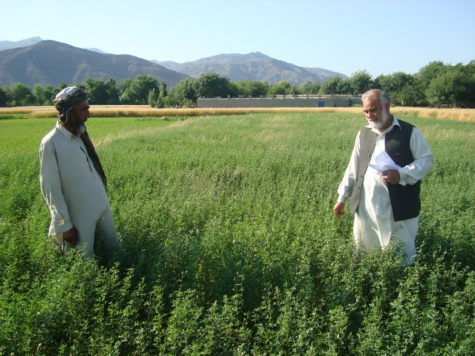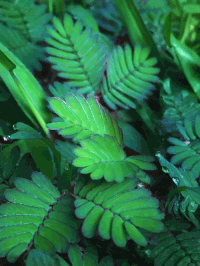Antianemic
Pumpkin
- Scientific Name: Curcurbita pepo L.
- Plant Family: Curcurbitaceae
- Parts Used: Fruit, Seeds, Leaves, Flowers
- Actions: Fruit: Antioxidant, Antidiabetic, rich in beta-carotene
- Actions: Seeds: Anti-anemic, Anthelmintic properties, isprenoid compound, high mineral content, and vitamin F
The Basics
Cooling thermal nature; sweet and slightly bitter flavor; relieves damp conditions including dysentery, eczema, and edema. Helps regulate blood sugar balance and benefits the pancreas – used for diabetes and hypoglycemia. Promotes discharge of mucus from lungs, bronchi, and throat. Regular use has been shown to benefit bronchial asthma. Cooked pumpkin destroys intestinal worms, but not as effectively as pumpkin seeds.
Pumpkin has long been used to treat common ailments, such as bloating, dehydration, fatigue, infertility, and certain skin conditions. Consuming it and topically applying its flesh are among the most popular medicinal uses of pumpkin, while mixing the roasted or ground seeds with other ingredients is also common. Moreover, the oil extracted from the pumpkin seeds can be used to create capsules. Though less common in the U.S., pumpkin leaves have been used in traditional Ayurvedic medicine as a pain reliever.
Traditionally, pumpkin was used for medicinal purposes in Mexico, China, America and Africa. The medicinal properties of pumpkins are normally obtained from either the extract from the stem, leaves, fruit or seeds.
The pumpkin is very useful as food and its seeds are highly valued for their health benefits as an anthelmintic and contain 50% of a fatty oil composed by oleic acid and linoleic acid. The pulp either raw or cooked is used as emulsifier.
It has a high content of carbohydrates, amino acids and vitamins B, C, D, E and K. It also contains minerals like calcium, potassium and phosphorus.
Other substances present in pumpkin are the glycoside (cucurbitin), albumin, lecithin, phytosterol and various resins.
Pumpkin is used for treating bladder irritation, kidney infections, intestinal worms, and trouble urinating due to benign prostatic hyperplasia (BPH).
- How does it work?
The chemicals in the pumpkin seed cause an increase in urination (diuretic effect), which helps relieve bladder discomfort. Pumpkin seed also contains a chemical that might kill intestinal worms.
Health Benefits
Pumpkin has a range of fantastic health benefits, including being one of the best-known sources of beta-carotene. Beta-carotene is a powerful antioxidant. It also gives orange vegetables and fruits their vibrant color. The body converts any ingested beta-carotene into vitamin A.
Beta-carotene is a powerful antioxidant. It also gives orange vegetables and fruits their vibrant color. The body converts any ingested beta-carotene into vitamin A. Consuming foods rich in beta-carotene may reduce the risk of developing certain types of cancer, offer protection against asthma and heart disease, and delay aging and body degeneration. Pumpkins are also a powerful source of fiber.
The potassium contained within pumpkins can have a positive effect on blood pressure. The antioxidants in pumpkin could help prevent degenerative damage to the eyes.
Many studies have suggested that eating more plant foods such as pumpkin decreases the risk of obesity and overall mortality. It can also help prevent diabetes and heart disease, and promote a healthy complexion and hair, increased energy, and a healthful body mass index (BMI).
They have demonstrated the following health benefits:
- Regulating blood pressure
Among the various other important nutritional benefits of pumpkin is its well-documented hypotensive effect. Pumpkins contain an abundance of phytosterols and vitamin E, which protect the heart by widening the blood vessels, preventing blood clots, and lowering blood pressure.
Eating pumpkin is good for the heart. The fiber, potassium, and vitamin C content in pumpkin all support heart health.
Studies suggest that consuming enough potassium may be almost as important as decreasing sodium intake for the treatment of hypertension, or high blood pressure. Decreasing sodium intake involves eating meals that contain little or no salt.
Increased potassium intake is also associated with a reduced risk of stroke, protection against loss of muscle mass, and preservation of bone mineral density.
- Reducing the risk of cancer
Research has suggested a positive relationship between a diet rich in beta-carotene and a reduced risk of prostate cancer.
Beta-carotene has also been shown to hold back the development of colon cancer in some of the Japanese population.
“We found a statistically significant inverse association between higher plasma lycopene [a type of beta-carotene] concentrations and lower risk of prostate cancer, which was restricted to older participants and those without a family history of prostate cancer.”
Pumpkins contain a wealth of antioxidants. Vitamin C, vitamin E, and beta-carotene have been shown to support eye health and prevent degenerative damage.
A cross-sectional study of older African-American women showed that eating 3 or more fruit servings per day was associated with a decreased risk of age-related macular degeneration. It also led to slower progression of the disease.
- Combating diabetes
Pumpkins have a powerful effect on glucose absorption. This can help keep diabetes at bay. Pumpkin also helps to control diabetes.
The plant compounds in pumpkin seeds and pulp are excellent for helping the absorption of glucose into the tissues and intestines, as well as balancing levels of liver glucose.
They may be associated with a lower risk of type 2 diabetes, but this effect is not consistently demonstrated. However, the compounds have such an impact that researchers suggest that they could be reworked into an anti-diabetic medication, though further studies are needed.
- Daily fiber content
Pumpkins are a fantastic source of fiber. People in the United States (U.S.) do not consume enough fiber, with an average daily intake of just 15 g. The recommended daily fiber intake of is between 25 and 30 g.
Fiber slows the rate of sugar absorption into the blood, as well as promoting regular bowel movements and smooth digestion. A healthful fiber intake can also help reduce the risk of colon cancer.
With nearly 3 grams (g) of fiber in cooked, fresh pumpkin and over 7 g in canned pumpkin, adding a serving of pumpkin to the daily diet can help supplement the fiber shortage in the average American diet.
- Pumpkin can protect immunity.
Pumpkin pulp and seeds are high in both vitamin C and beta-carotene. These offer a boost to the immune system using a powerful combination of nutrients.
Beta-carotene is converted into vitamin A. This triggers the creation of white blood cells that fight infection.
Vitamin E and zinc work together to help activate different cells in the immune system, which makes pumpkin beneficial for preventing common illnesses.
- Treating Common Skin Conditions
Pumpkins are believed to have originated in North or Central America. In that region, traditional healers have long used pumpkin as a treatment for common skin conditions. In the Yucatan Peninsula, for example, pumpkins are applied topically to burns, sores, and blisters. The effectiveness of this practice has been validated by modern science.
Powerful antioxidants in pumpkin are beneficial for maintaining the health of the skin.
- Maintaining Healthy Vision
Pumpkins get their distinctive color from the presence of plant carotenes, which are easily converted into vitamin A in the body. Both vitamin A and beta-carotene help to protect the eyes from damage, especially when adjusting to the dark after being in bright light.
- Maintaining proper hydration.
Staying hydrated is of profound importance for the human body, which uses water to maintain healthy cellular growth and to perform just about every other major bodily function. Therefore, pumpkins – which are low in calories and composed of about 90% water – have been used as a cure for thirst and dehydration.
- Supporting reproductive health.
Vitamin A and zinc play an important role in supporting healthy fetal growth and development during pregnancy while caring for the reproductive system overall. In some ancient traditions, pumpkins were used as a fertility boost and as a treatment to help new mothers produce milk for nursing.
Medicinal Uses of the Seeds
Pumpkin seeds as a disease-preventative, has been little noticed until now. Used for prostate disorders, stomach problems, worms, and nausea as in morning sickness, motion sickness and swollen prostate. The oil of the seeds are useful for healing wounds, especially burns, and for chapped skin.
Good source of plant protein, high mineral content, and vitamin F.
Traditional folk medicine touts pumpkin seeds as an effective treatment for prostate enlargement. Anti-inflammatory agents, known as phytosterols, combine with the healing properties of zinc to potentially reduce the size of the prostate.
Pumpkin seeds are just about the richest natural sources of zinc nutrition ever found. The use of pumpkin seeds for their beneficial effect on the prostate gland is as old as the ages. (Referred to as He-man power). A decoction of the unhulled seeds have long been of use in domestic folk-medicine.
The rejuvenating powers for men are extolled with praise by popular medicine both in America and in Europe. Experience reveals that men in those countries where the seeds of the pumpkin plant are copiously eaten throughout a lifetime remain amazingly free of prostatic hypertrophy (prostate trouble) and all its consequences.
Men without prostate trouble show high zinc concentrations; while men with the sick prostate have low zinc concentrations. Studies show that in regions where there is a widespread deficiency of zinc, the sex organs to not develop properly.
The seed has refreshing and soothing properties, is given as “seed milk” for nephritis and inflammation of the bladder and urethra.
From the pumpkin seeds is extracted an oil very good for household and medicinal uses. Oil extracted from pumpkin seeds contains about 50% vitamin E, which shields the skin from damage caused by free radicals and is used for the necessary cellular communication the skin needs to heal itself. A one-ounce serving of pumpkin seeds can provide about 28% of the recommended intake of zinc, which also plays a role in wound healing.
Pumpkins can provide a necessary energy boost as a treatment for general fatigue. A one-ounce serving of pumpkin seeds provides about 53% of the recommended daily intake of magnesium, a vital nutrient that is required for the production of energy.
Traditional use of seeds for the treatment of intestinal infections led the United States Pharmacopoeia to list pumpkin seeds as an official medicine for parasite elimination from 1863 to 1936. More recently, a research conducted in China and Russia showed that pumpkin seeds help treat tapeworm infestations.
In China pumpkin seeds were used to be treat people with acute schistosomiasis, a severe parasitic disease that is transmitted through snails.
Presently, there are very good interventions against bacterial infections in form of antibiotics. However, the misuse of antibiotics is causing some bacteria to become resistant warranting development of new drugs or turning to natural remedies.
Proteins and oil extracted from pumpkin seeds are good candidates for such drugs since they inhibit growth of wide range of bacteria, fungi and yeast.
- Anti-bladderstone
Two trials in Thailand have reportedly found that eating pumpkin seeds as a snack can help prevent the most common type of kidney stones.
Pumpkin seeds appear to both reduce levels of substances that promote stone formation in the urine and increase levels of substances that inhibit stone formation.
Approximately 5–10 grams per day of pumpkin seeds may be needed for kidney stone prevention. However, the active constituents of pumpkin seeds responsible for this action have not yet been identified.
Pumpkin seeds are high in protein to the extent that a gram of protein from pumpkin seeds contains the same amount of essential amino acid called tryptophan as a glass of milk.
- Antidepressant
Due to high levels of tryptophan content in pumpkin seeds, the seeds have been recommended to treat depression.
Tryptophan is an amino acid that raises levels of serotonin ‘happiness-inducing hormone’ in the brain.
- Anti-inflammatory
In 1995, Fahim, from University of Cairo, Egypt showed that oil extracted from pumpkin seeds has anti-inflammatory properties similar to indometacin, a well known anti-inflammatory drug.
Fahim and his colleagues effectively treated rats experiencing artificially-induced arthritis using pumpkin seeds oil, confirming that the pumpkin seed oil has strong anti-inflammatory properties.
Description:
Botanically speaking, pumpkin is considered to be a fruit. Pumpkin fruits are a type of botanical berry known as a pepo. This is because it has seeds and develops from the mature ovary of pumpkin blossoms.
Since some squash share the same botanical classifications as pumpkins, the names are frequently used interchangeably. One often-used botanical classification relies on the characteristics of the stems: pumpkin stems are more rigid, prickly, and angular (with an approximate five-degree angle) than pumpkin stems, which are generally softer, more rounded, and more flared where joined to the fruit.
The pumpkin is a large, annual, creeping plant; the stem, which may reach a length of 30 feet, has branched tendrils and bears alternate, stiff-haired, triangular or ovate-triangular leaves that may be sharply or weakly lobed. The leaves are larger than a hand and have irregularly sharp-serrate margins.
Solitary, yellow, funnel-shaped flowers with pointed lobes grow on angular peduncles that expand where the flower attaches. Flowering time is from June to August. The fruit is the familiar large, orange, furrowed pumpkin which contains numerous white, elliptic seeds. This is the pumpkin made into jack-o-lanterns at Halloween.
Habitat and Cultivation:
Pumpkins are a warm-weather crop usually planted in early July. Widely cultivated in warm and temperate climates, this annual plant has a short cycle and in the tropics, can be planted as early as March and then again in June,.
Pumpkins have rampantly-growing vines that need a lot of room to breathe and spread out as the plant grows. Pumpkin plants should be planted near the end of spring, as they crave warm soil, and seeds will not germinate in cold temperatures. The fruit can be harvested in 18 – 24 weeks.
The specific conditions necessary for growing pumpkins require that soil temperatures 8 centimeters (3 in) deep are at least 15.5 °C (60 °F) and soil that holds water well. Pumpkin crops may suffer if there is a lack of water or because of cold temperatures (in this case, below 18 °C or 65 °F; frost can be detrimental), and sandy soil with poor water retention or poorly drained soils that become waterlogged after heavy rain.
Pumpkins are, however, rather hardy, and even if many leaves and portions of the vine are removed or damaged, the plant can very quickly re-grow secondary vines to replace what was removed.
Propagation of the pumpkin plant generally occurs when bees transfer pollen from the male flowers to the female flowers. However, it can also be accomplished through human intervention by hand-pollinating the pistil of a female flower.
Pumpkins have historically been pollinated by the native squash bee Peponapis pruinosa, but this bee has declined, probably at least in part to pesticide sensitivity, and today most commercial plantings are pollinated by honeybees. One hive per acre is recommended by the U.S. Department of Agriculture. If there are inadequate bees for pollination, gardeners often have to hand pollinate. Inadequately pollinated pumpkins usually start growing but abort before full development.
Collection:
- Harvesting the Flowers
The female blossoms will become the fruit so in order to preserve your harvest, it is best to pick the male blooms. Being aware of the difference between male and female blooms is important to know when picking pumpkin blossoms.
Male pumpkin blossoms are hairier and have a thin base where they attach to the stem. Females have a thick bulge, which is the ovary, where they grow from the plant.
Morning is the best time for harvesting pumpkin flowers. Choose male flowers when they are still in bud form. Male flowers grow first on the plant but the fully formed blooms are hairy and difficult to handle in the kitchen. Female blooms are considered the tastiest but you should minimize their harvest if you want fruit on the plant.
Give a gentle squeeze to the back of the bloom when picking pumpkin flowers. This will help you detect the bulb of a female or the flat end of a male flower.
- How to Store Pumpkin Blossoms:
The optimum condition is to use them the day of harvest. Picking pumpkin flowers and then using them immediately gives you the freshest taste of spring. Pumpkin flowers are very delicate and don’t store for long. However, there is a trick on how to store pumpkin blossoms for best flavor and to extend the life of the blooms. Keep them in the refrigerator. Male blooms last the longest and can be stored in the refrigerator for up to a week. Either sex will keep best if laid out gently on tissue or a paper towel on a dish or flat container.
- Harvesting the Fruit:
Your best bet is to harvest pumpkins when they are mature. They will keep best this way. Do not pick pumpkins off the vine because they have reached your desired size. If you want small pumpkins, buy a small variety. A pumpkin is ripening when its skin turns a deep, solid color (orange for most varieties).
When you thumb the pumpkin, the rind will feel hard and it will sound hollow. Press your nail into the pumpkin’s skin; if it resists puncture, it is ripe.
To harvest the pumpkin, cut the fruit off the vine carefully with a sharp knife or pruners; do not tear. Be sure not to cut too close to the pumpkin; a liberal amount of stem (3 to 4 inches) will increase the pumpkin’s keeping time.
Handle pumpkins very gently or they may bruise.
Pumpkins should be cured in the sun for about a week to toughen the skin and then stored in a cool, dry bedroom, cellar, or root cellar—anywhere around 55ºF.
- Harvesting the Leaves
Pick the young-medium aged leaves (not the older tougher ones), and use them in cooked recipes like you would a spinach or a heavy winter green.
Covered in fuzz and possessing a thick, fibrous spine, pumpkin leaves aren’t all that intuitively edible. They take a little bit of advance preparation before you can use them in recipes.
Here is a simple method:
“Holding the leaf upside down by its stem, you see that the stem is hollow. Use your thumbnail to split half or a third of the stem and snap it backward so that the flesh breaks cleanly, but the outer fibers do not. Pull gently, removing the fibers from the outside of the stem and the back of the leaf. Repeat until you have de-strung a good pile, because, like all greens, pumpkin leaves cook down quite a bit.”
Once you’ve de-strung a pile of pumpkin leaves, you can cook them in a variety of ways. In Malawi, they are often simmered simply with tomatoes just for a few minutes until the leaves are tender.
- Harvesting and Preparing the Seeds
To harvest your pumpkin seeds, slice open your pumpkin (to eat or to make as a jack-o-lantern). Scoop out the seeds with your hands or a large, sturdy spoon. Place the seeds in a bowl. *Some pumpkin varieties have seeds with white husks over the nut meat, and some just contain the green nutmeat, aka “pepitos.”
You can process and eat pumpkin seeds the same way, regardless of the variety.
Heat a frying pan and add enough high heat vegetable oil (we like organic sunflower, grapeseed, or raw coconut oil) to sauté them. Once the pan is hot, add the pumpkin seeds. *Don’t worry if there is a little bit of pumpkin string still attached, this cooks up fine and adds some nice flavor & nutrition.
As soon as the seeds are in the pan, add some fresh ground sea salt. Stir repeatedly to ensure light, even browning uniformly on the seeds’ surfaces. Let them cool down, but eat them while they’re still warm for best flavor! They’ll also store for a long time and make a great, healthy alternative to potato chips.
Preparation and Dosage:
- Pumpkin Seeds:
Very helpful in removing the Taenia Solium and Taenia Saginata. To use for worms, crush 7-14 oz. peeled pumpkin seeds for children, up to 25 oz. for adults, and stir into fruit juice, honey, or syrup to make a mash and gradually taken over the course of 1 hour.. 2-3 hours later, take castor oil or some type of laxative to expel the parasites. Take care, especially with tapeworm, that the entire worm is expelled.
A good remedy for burns is 30 g of pulp per liter of water and makes a porridge with the mix.
- Pumpkin Seed Oil:
For benign prostatic hyperplasia (BPH): 480 mg of pumpkin seed oil extract per day in 3 divided doses alone or in combination with saw palmetto and other herbs.
As a food source:
The edible parts of a pumpkin are the leaves, fruit and the seeds. High nutrients and medicinal properties in pumpkin leaves, fruit and seeds make it an attractive health food proposition.
The pumpkin’s flesh can be either sweet or bitter, and it is commonly used in pies, scones, soups, stews, and other recipes.
- Pumpkins are high in protein and fiber, but low in fat. They are an excellent source of iron and vitamin A.
- Cooked pumpkin provides about 20 calories and 4.90 g of carbohydrates per 100 g serving.
Pumpkin flower blossoms have a light, buttery taste. They are sometimes prepared as vegetables in a number of pasta, soup, and salad recipes.
Pumpkin leaves are also edible. They are chock-full of iron, and may be prepared like other dark green, leafy vegetables. How do they taste? Here’s a review:
“The pumpkin greens lacked any bitterness that other greens tend to have, which surprised me. These might be the sweetest greens I have eaten. Even my son and wife enjoyed them. The flavor reminded me of a mixture of green beans, broccoli, spinach and asparagus.”
Pumpkin seeds are usually roasted and consumed as healthy, protein-packed snacks.
The young fruit of a pumpkin is best used in savory entrees and sides, while the mature fruit goes best in pies and other sweet desserts. Medium-sized varieties, like ‘Autumn Gold’, ‘Jack-o-Lantern’, and ‘Spirit’ are among the best for culinary use; however, larger varieties like ‘Big Tom’ and ‘Jackpot’ are also popular.
When ripe, the pumpkin can be boiled, steamed, or roasted. Pumpkins that are still small and green may be eaten in the same way as pumpkin or zucchini.
In addition the fruit can be baked by cutting it into two halves, scooping out seeds and placing the hollow side down in a big tray followed by baking in an oven.
Preparing fresh pumpkin at home will deliver the most benefits for your health, but canned pumpkin is also a great choice. Pumpkin retains many of its health benefits in the canning process.
Pumpkin pie is a sweeter way to incorporate the benefits of pumpkin into the diet. Be sure to make a pumpkin puree rather than buying pre-made. Steer clear of canned pumpkin pie mix. This is usually placed next to the canned pumpkin in grocery stores, and is sold in a similar can. It contains added sugars and syrups.
- Canned pumpkin should have only one ingredient: Pumpkin.
Pumpkin is a highly nutrient-dense food. It is rich in vitamins and minerals but low in calories. Pumpkin seeds, leaves, and juices all pack a powerful nutritional punch. Although the variety of pumpkins that usually ends up carved into a jack-o-lantern is perfectly edible, it is best to cook with the sweeter and smaller sweet or pie pumpkin varieties.
Make sure the pumpkin has a few inches of stem left and is hard and heavy for its size. Store uncut pumpkins in a cool, dark place for up to 2 months.
The most common preparation methods of pumpkin involve desserts like custards and pies. One of the simplest ways to enjoy the contents is to gently roast or dehydrate the seeds in sea salt and other preferred spices.
There are many ways pumpkin can be incorporated into desserts, soups, salads, preserves, and even as a substitute for butter.
- Use pumpkin puree or canned pumpkin in place of oil or butter in any baking recipe.
- Make a quick treat of pumpkin chocolate yogurt by combining Greek yogurt, pumpkin puree or canned pumpkin, honey, cinnamon, and cocoa powder.
Pumpkin fresh flowers add flavor to salads. Eaten as a side dish, the recipe is as follows: Pick flowers when vines are blooming, wash and roll in paper towel to dry. Dip in beaten egg, roll in fine bread or cracker crumbs and fry in buttered pan.
In the southwestern United States and Mexico, pumpkin and pumpkin flowers are a popular and widely available food item. They may be used to garnish dishes, and they may be dredged in a batter then fried in oil.
The pumpkin fruit is a good weaning food when mashed together with salmon and broccoli or any other vegetables.
- Pumpkin seed oil
Pumpkin seed oil, a thick oil pressed from roasted pumpkin seeds, appears red or green in color depending on the oil layer thickness, container properties and hue shift of the observer’s vision. When used for cooking or as a salad dressing, pumpkin seed oil is generally mixed with other oils because of its robust flavor.
Used in cooking in central and eastern Europe, it is considered a delicacy in traditional local cuisines such as for pumpkin soup, potato salad or even vanilla ice cream. Pumpkin seed oil contains fatty acids, such as oleic acid and alpha-linolenic acid.
Historically:
Though information about where pumpkins originated remains largely unclear, they have been observed growing wild in parts of northeastern Mexico. The earliest known record of human domestication and consumption of pumpkins comes from Mexico, where remnants of seeds and pumpkines have been found in the Oaxaca valley and Tamaulipas dwellings – perhaps dating as far back as 8750 BCE and 7000 BCE, respectively. Additional findings in Missouri (4000 BCE) and Mississippi (1400 BCE) are also relevant.
After domestication, pumpkins were transported to other parts of the world by boat during the colonial era. The earliest evidence of pumpkins in Europe, for example, can be found in a prayer book made for Anne de Bretagne, the duchess of Brittany, between 1503 and 1508. Once domesticated, the crop produced larger fruit, developing more colors and sizes, compared with the wild plant.
Many culinary uses for pumpkin have developed over time. There is some evidence to suggest that the ancient Aztecs enjoyed pumpkin seeds as a quick but satiating snack. Native Americans roasted long strips of pumpkin to eat, while European colonists are responsible for the origin of pumpkin pie – they would cut off the pumpkin top, remove the pumpkin’s seeds, and fill it with honey, milk, and seasonings before baking it in hot ashes.
Names From Around The World:
- Afrikaans: pampoen
- Arabic: qar’ miskî , qar’miski, qara’ sudani, qar’ah yábisah
- Chinese: nan gua, nam gua, fan gua, fan kua, jin dong gua, zhong guo
- Czech: tykev pimová
- Danish: centnergræskar, kroghals, krumhalsgréskar, moskusgréskar
- Dutch: pompoen, reuzenkalebas
- English: pumpkin, pumpkin, summer squash, winter squash, ornamental gourd
- Finnish: jättiläiskurpitsa
- French: citrouille, potiron, potimarron, pompon, courge (gourde), courgette, giromons (giraumon/giraumont), calabasse, patisson
- Gaelic: peapag
- German: kürbis (kirbiz)
- Greek: pepon
- Hebrew: delaat
- Hindi: vilayati kaddu
- Hungarian: pézsmatök
- Italian: popone, cocuzza, zucca
- Japanese: kabocha, kabotcha
- Korean: hipak
- Latin: Cucurbita, Cucurbita pepo, Cucurbita pepo L., Cucurbita argyrosperma, Cucurbita maxima, Cucurbita moschata
- Norwegian: muskatgraskar
- Polish: dynia pizmowa
- Portuguese: abóbora, jerimum (jerimu, jerumu, jirimu, jirumum, jurumu, gerimum, gurumu, girimu, girumum)
- Russian: tykva, tykva krupnoplodnaja
- Slovenian: mukatna bua
- Spanish: calabaza, tamalayotl
- Swedish: bisampumpa
- Tagalog: kalabasa
- Thai: fak thong, namtao farang
- Vietnamese: bi do, bi ngo
- Yoruba: elegede
Folklore:
This fruit is sacred to the Yoruban goddess Oshun and is offered to her in exchange for wishes granted concerning love, money and fertility. Offer whole pumpkins smeared with honey to the river where you wish to conceive a child. Offer whole pumpkins with names carved into them for love spells. Throw a handful of pumpkin seeds into the river and ask for a financial boon. It is important to know that the pumpkin and its seeds are considered the children of Oshun. If you are working with her magick, you must abstain from eating any pumpkin.
Some say that early American legend maintained that leaving a half of a pumpkin open or exposed in any room, but especially the kitchen, would attract negative energies into your living space. Pumpkins that have begun to spoil were believed by the Romany to suck the life energy from the people around them, and create illness and bad luck.
Halloween Pumpkins
Pumpkins are commonly associated with the spooky jack-o-lanterns that children make with their families to light the night every Halloween. Because of their hard outer skin and soft, fleshy innards, pumpkins can be carved, then scooped out, and later preserved on front porches in the days leading up to the Halloween festivities. Since pumpkins may vary drastically in their color, size, shape, and general appearance, some will make good jack-o-lanterns, while others are good for decorative and ornamental use in centerpieces, as well as on windowsills.
Throughout Britain and Ireland, there is a long tradition of carving lanterns from vegetables, particularly the turnip, mangelwurzel, or swede. The practice of carving pumpkins for Halloween originated from an Irish myth about a man named “Stingy Jack”. The turnip has traditionally been used in Ireland and Scotland at Halloween, but immigrants to North America used the native pumpkin, which are both readily available and much larger – making them easier to carve than turnips. Not until 1837, does jack-o’-lantern appear as a term for a carved vegetable lantern, and the carved pumpkin lantern association with Halloween is recorded in 1866.
Other Uses:
Native Americans used pumpkins to meet a number of home décor needs. Dried strips of pumpkin were often used to weave mats during ancient times. They also used the thick shells as carrying containers. This method could be adapted for vases and other modern DIY projects.
Canned pumpkin is often recommended by veterinarians as a dietary supplement for dogs and cats that are experiencing certain digestive ailments such as constipation, diarrhea, or hairballs. The high fiber content helps to aid proper digestion.
Raw pumpkin can be fed to poultry, as a supplement to regular feed, during the winter to help maintain egg production, which usually drops off during the cold months.
Commercial Uses
Generally pumpkin is under-utilized and under valued, although it can be converted to commercially valuable products such as purees, jams and marmalades.
In 1972, Stephanie Lapinig was among the first to seriously explore the commercialisation of pumpkins by obtaining a patent in US for converting pumpkin mesocarp into sour and sweet pickle.
The patent involves chilling pumpkin in high salt concentration for over 5 hours to obtain crispiness. This is followed by addition of vinegar and sugar.
Others have followed the steps of Stephanie including Egbekun from Nigeria school of Technology who successfully developed a pumpkin marmalade with no difference in sensory attributes such as taste, spreadability and overall acceptability when compared to orange marmalade.
Pumpkin ketchup has been rated closely to tomato ketchup by scoring 2 compared to tomato ketchup that scored 3.2, suggesting that its perceived quality is slightly lower but very close to that of tomato ketchup.
Several food companies in Britain, America and China make canned pumpkin puree which is a popular food for weaning.
Bread when stored, loses its freshness by staling, addition of pumpkin pulp to bread flour slows staling and generally improves the quality of bread.
Due to high protein content in pumpkin seeds, adding the seed’s flour to wheat flour makes composite flour high in protein for making bread and cookies.
Cosmetic Uses
Pumpkin is packed with skin-loving nutrients like antioxidants, zinc, vitamins A and C, fruit enzymes and alpha hydroxy acids. Pumpkin flesh can help to nourish, brighten and smooth skin, as well as boost collagen and help tame the signs of aging, according to The International Dermal Institute.
You can use cooked fresh pumpkin puree, or canned if you have some. If you are using canned pumpkin, check the ingredients. There should be just one ingredient – pumpkin. Pumpkin pulp can be mixed with honey, oils, and other natural ingredients for a rejuvenating homemade facial mask, body scrub, and hair conditioner.
The pumpkin flower has found purpose in a number of fragrances and cosmetics due to its sweet and delicate aroma.
Pumpkin seed oil is high in antioxidants like vitamin E, which aids in cell regeneration to help protect skin cells from damage. Pumpkin seed oil-based creams and moisturizers smooth the skin’s appearance, and may be a positive addition to skincare regimens.
Special Precautions and Warnings:
Pumpkin is safe in food amounts and considered POSSIBLY SAFE in medicinal amounts for most people. It may cause ejaculation problems in some men.
Not enough is known about the use of pumpkin in medicinal amounts during pregnancy and breast-feeding. Stay on the safe side and stick with usual food amounts.
Drug Interactions:
- Lithium interacts with Pumpkin
Pumpkin might have an effect like a water pill or “diuretic.” Taking pumpkin might decrease how well the body gets rid of lithium. This could increase how much lithium is in the body and result in serious side effects. Talk with your healthcare provider before using this product if you are taking lithium. Your lithium dose might need to be changed.
Recipes, Formulas, and Lore:
Alfalfa
- Scientific Name: Medicago sativa
- Plant Family: Fabaceae
- Parts Used: The leaves, sprouts, and seeds.
- Actions: anti-anemic, appetizer, diuretic, galactagogue, laxative, nutrient, tonic.
- Qualities: Neutral thermal nature; Bitter flavor; Dries dampness, Spring, Yin
The basics:
Alfalfa follows the doctrine of signatures: its ability to produce exceptional roots benefits our “roots,” which are often identified physiologically as our intestines and kidney/bladder functions. Alfalfa cleans and tones the intestines and takes harmful acids out of the blood. It benefits the urinary system and intestines and detoxifies the body.
Alfalfa contains eight enzymes which help assimilate protein, fats, and carbohydrates. It is safe food even for children and helps nursing mothers produce more milk.
In ancient India, Ayurvedic texts prescribe the use of Alfalfa seeds and sprouts for improving blood cell production and its leaves and stem as a good source of protein and minerals.
Nutritional Value:
Alfalfa is rich in chlorophyll, carotene, protein, calcium and other minerals, vitamins in the B group, vitamin C, vitamin D, vitamin E, and vitamin K. Other important nutrients include iron, magnesium, potassium, phosphorus, sodium, sulfur, silicon, chlorine, cobalt, and zinc. Alfalfa also contains vitamins K and P, and abundant chlorophyll.
The sun-dried hay of alfalfa has been found to be a source of vitamin D, containing 48 ng/g (1920 IU/kg) vitamin D2 and 0.63 ng/g (25 IU/kg) vitamin D3. There is also reference to vitamin D2 and vitamin D3 being found in the alfalfa shoot.
Medicinal uses:
Alfalfa is used medicinally in a variety of ways, depending on the country, culture, and healing tradition.
- In China it is considered to have the following qualities: Anodyne, Depurative, Emetic and is used to treat Fever, Gravel, and Dysuria.
- In Iraq it is commonly used to treat Arthritis.
- In Turkey, in addition to treating Arthritis, it is considered to be a Cardiotonic and used to treat Scurvy.
- In the United States it is believed to be Cyanogenetic, and used in the treatment of and prevention of Cancer.
- Elsewhere it is used to treat Arthritis, Boils, as an Emmenagogue, Lactagogue, and for Scurvy.
Note: In this day and age of global information via the internet and social media, these dividing lines have become increasingly blurred.
Alfalfa is used for kidney conditions, bladder and prostate conditions, and to increase urine flow. It is also used for high cholesterol, asthma, osteoarthritis, rheumatoid arthritis, diabetes, upset stomach, and a bleeding disorder called thrombocytopenic purpura. People also take alfalfa as a source of vitamins A, C, E, and K4; and minerals calcium, potassium, phosphorous, and iron.
Other uses include edema, weight loss, bladder stones, plantar warts, chronic sore throat, fevers, gas pains, peptic ulcers, drug and alcohol addiction recovery.
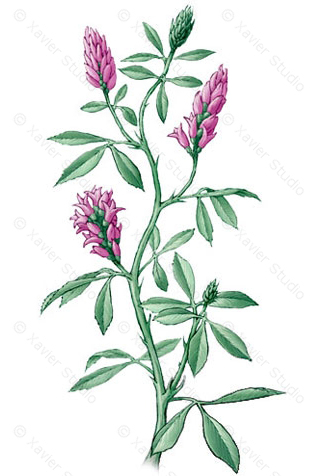 Alfalfa is helpful for chronic joint inflammation and aiding female hormonal balance. It comforts and strengthens the immune system. Alfalfa is rich in vitamins, minerals and other nutrients that play an important role in the maintenance of a healthy body. It contains protein, vitamin A, vitamin B1, vitamin B6, vitamin C, vitamin E, and vitamin K. It also contains calcium, potassium, carotene, iron and zinc and is considered one of the healthiest plant foods, providing an excellent range of nutritive properties for good health and well being.
Alfalfa is helpful for chronic joint inflammation and aiding female hormonal balance. It comforts and strengthens the immune system. Alfalfa is rich in vitamins, minerals and other nutrients that play an important role in the maintenance of a healthy body. It contains protein, vitamin A, vitamin B1, vitamin B6, vitamin C, vitamin E, and vitamin K. It also contains calcium, potassium, carotene, iron and zinc and is considered one of the healthiest plant foods, providing an excellent range of nutritive properties for good health and well being.
Interestingly, alfalfa is a treatment hay fever. Externally the seeds can be made into a poultice for boils, to soothe insect bites, and reduce inflammation. It alkalizes and detoxifies the body. Binds carcinogens in the colon to help speed up their elimination from the body.It is an overall tonic for general health, fatigue, weight gain, and debility. Alfalfa also stimulates the growth of supportive connective tissue, and is useful in the treatment of diabetes.
Alfalfa is a herb rich in protein and the vitamins A, D, E and K. The leaves contain eight of the essential amino acids.Such a a nutrient-rich formula, can be used to replenish the body with vitamins and minerals. It is specifically indicated for those with poor diets and inadequate nutrient intake.
Daily Dosages:
In addition to alfalfa sprouts found in most supermarkets, alfalfa is available as a dried leaf herb, in tablets, capsules, and powders.
- 2 to 3 cups tea
- 2 to 4 grams in capsules or pills 3 times a day
- 6 to 12 grams powder
- 3 ounces sprouts
To make tea, steep 1 tablespoon seed or 2 ounces dried leaf in 1 quart boiling water. In powder form, the pleasant taste of alfalfa is a welcome addition to soups and salads.
For high cholesterol: a typical dose is 5 to 10 grams of the herb, or as a steeped strained tea, three times a day. 5 to 10 mL of a liquid extract (1:1 in 25% alcohol) three times a day has also been used.
Herbal Combinations:
To get more natural vitamins, combine Alfafa with herbs such as Nettle and Rosehip, Nettle is high in both vitamin C and Iron, thus ensuring that energy levels and prevention of cellular damage is assisted. Nettles acts as a blood tonic with the ability to strengthen the body’s natural resistance. Rosehip is also extremely high in vitamin C and is one of the best herbs used for its antioxidant action on the body. It also assists with maintaining healthy collagen.
Cosmetic Uses:
Alfalfa extract (Medicago Sativum Extract) can be an antioxidant in skin-care products, it is said this extract is a great source of protein, minerals and vitamins C,D,E,K for the skin. Conditions and increases skin metabolism to promote skin healing,used as a topical skin conditioner.Alfalfa Extract is primarily used in manufacture of natural face masks and lotions. Saponins in alfalfa extract acts as natural foaming agent. Boots, Clarins and Lancome are using alfalfa extract in their skincare products. Continue reading
Rennie Luttrull: queen-annes-lace-seeds
Rosanna: Spignel aka Bald Money
Annamarie Squatrito: Fumitory
EILEEN Klinghagen: Pumpkin
Mahmudul Hasan: Celery
